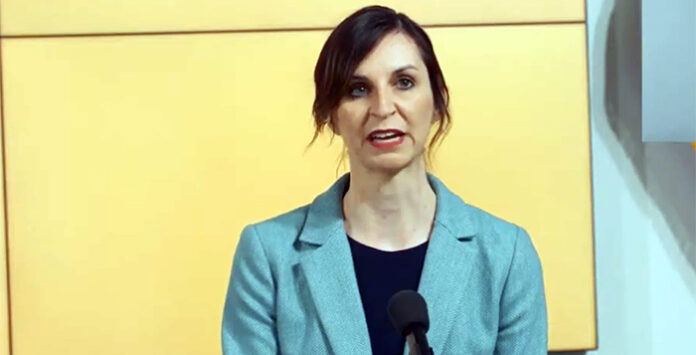
While extending the closure time of some businesses, Gov. Doug Ducey pulled a start date for schools “off the table.”
State Superintendent Kathy Hoffman said setting a definite opening date would be “unreasonable.” A framework for returning to class is expected to be available to public schools by Aug. 7.
Meanwhile local school leaders can decide when they can physically open.
“The student and staff of MUSD can feel confident that the local leadership of our Governing Board, district administration and school staff will prioritize health and safety and the use of data to determine the next steps for the students and families we serve,” MUSD Superintendent Tracey Lopeman said.
During his weekly update Thursday, afternoon, Ducey claimed a downward trend in daily reported cases, hospital bed use, intensive care unit bed use and respirator use due to COVID-19. He said there has been a slowdown in testing because of a lack of public interest.
The governor said schools should begin distance learning by the first day of their traditional calendar. Most schools in Maricopa already moved their start dates back a week or more. Maricopa Unified School District beings July 30 online and, for now, plans to return to campus Sept. 8.
The state will still require 180 days of instruction or equivalent hours.
One of the few mandates laid down for reopening school campuses is the use of face coverings. By the governor’s order, the state is requiring schools to have face-coving policies in place. Ducey said all adult will be required to wear a mask, with some health exceptions. Students will have exceptions in situations where they can socially distance or meet CDC guidelines for exemption.
“With each Executive Order, we wait for interpretation and guidance on the practical application in our unique system. We are pleased with the focus on data and the dedication to fully fund distance learning,” Lopeman said. “We anticipate clarity around on-site learning requirements for vulnerable students and will work with those guidelines to supplement the plans already in place to support all students and families.”
Hoffman clarified a requirement that all schools have a “safe place” for in-person instruction that would provide internet connection and supervision.
“We do have students for whom school is the safest place for them,” she said. “A district doesn’t have to have that in every school. It can be in just one school.”
Hoffman said the state has been talking to organizations about becoming community partners. That includes the Boys & Girls Club, which is opening a branch at Santa Cruz Elementary School.
Initially, the state had stipulated that schools that do not return to classes by a start date laid out by the state but continued online instead, there would be repercussions in its funding via average daily membership calculations.
That was further explained Thursday, laying out grant options.
“Schools will be eligible for one of the following options, whichever generates the higher amount on the 40th day:
“Option A: 5% grants for all students
i. Those students in an in-person classroom setting will be eligible for 1.0 average daily membership (ADM) that the state funding formula provides, plus the 5% grant totaling 1.05 ADM
ii. Those students who will be learning virtually (that is, on a device with a remote teacher, or at home with packets and other distance learning materials) will be eligible for the .95 that the state formula provides plus the 5% grant, totaling 1.0 ADM
“Option B: 98% of the prior year’s weighted ADM.”
Ducey said he will use $370 million more from the federal CARES Act money supplied to the state for the school grants.
Citing the discrepancies in technology among various schools in the state, Ducey said the state will invest $40 million to expand broadband in rural communities, $20 million for high-need schools, $6 million for the Arizona Teacher Academy and hundreds of thousands more to other achievement-gap programs.
Hoffman said many districts have opted to remain online until after fall break.
“MUSD has been planning for the start of the school year for months. In response to the effects of the pandemic, we crafted a sustainable blueprint that prioritizes safety and health, and allows us to shift seamlessly between distance and in-person learning,” Lopeman said. “We have invested in our students’ educational experience by providing each one with a district-issued laptop, purchasing a research-based digital curriculum and emphasizing how we nurture relationships in this unusual environment. We can’t wait to get started on July 30, 2020.”




![Elena Trails releases home renderings An image of one of 56 elevation renderings submitted to Maricopa's planning department for the Elena Trails subdivison. The developer plans to construct 14 different floor plans, with four elevation styles per plan. [City of Maricopa]](https://www.inmaricopa.com/wp-content/uploads/2024/04/city-041724-elena-trails-rendering-218x150.jpg)

![Affordable apartments planned near ‘Restaurant Row’ A blue square highlights the area of the proposed affordable housing development and "Restaurant Row" sitting south of city hall and the Maricopa Police Department. Preliminary architectural drawings were not yet available. [City of Maricopa]](https://www.inmaricopa.com/wp-content/uploads/2024/04/041724-affordable-housing-project-restaurant-row-218x150.jpg)










![Elena Trails releases home renderings An image of one of 56 elevation renderings submitted to Maricopa's planning department for the Elena Trails subdivison. The developer plans to construct 14 different floor plans, with four elevation styles per plan. [City of Maricopa]](https://www.inmaricopa.com/wp-content/uploads/2024/04/city-041724-elena-trails-rendering-100x70.jpg)